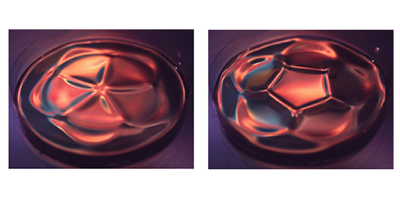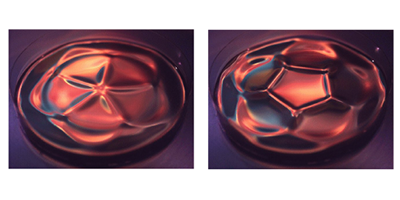Star-Shaped Waves
The ocean can produce exotic wave forms, such as “freak” waves, when normal waves combine in just the right way. These unusual wave patterns can—theoretically—take on a variety of different shapes, but researchers have so far only managed to produce a few distinct cases in the lab. As reported in Physical Review Letters, Jean Rajchenbach and colleagues at CNRS and the University of Nice in France have produced star- and polygon-shaped standing waves by vertically shaking a vessel filled with liquid oil.
Ocean waves and similar fluid waves are called surface gravity waves because the main restoring force is gravity. The basic equations describing these waves are nonlinear, which means that waves of different wavelengths can interact with each other and, under certain conditions, form unusual patterns, such as long-lasting solitary waves (solitons), U-shaped, and X-shaped waves. Such wave forms sometimes have important counterparts in other scientific domains, from optics to cold-atom physics.
To explore novel nonlinear possibilities, Rajchenbach and his collaborators placed a thin layer of silicon oil in a flat vessel and shook it up and down at a rate of around hertz. They initially observed circularly symmetric standing waves, but as they increased the shaking amplitude, the wave crests formed edges and vertices in an alternating pattern of five-pointed stars and pentagons. Varying the fluid depth and the shaking parameters produced other star-polygon shapes with three, four, and six sides. However, the vessel shape was not a factor, as identical patterns appeared in both circular and rectangular vessels. The authors explain how the observed shapes could arise from a resonant nonlinear interaction between three different waves generated by the shaking action. – Michael Schirber





